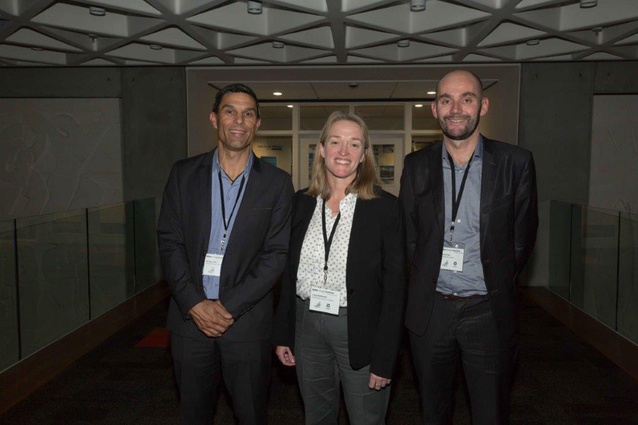Healthier homes: Homestar v.4 launch
The NZGBC Homestar version 4 tool launched in Auckland on Tuesday 25 July to a full capacity crowd at Beca auditorium, hosted by chief executive Andrew Eagles.
There were a range of interesting speakers on the night, including Peter Wolfkamp (Resident Builder), Tracey Wadsworth (Tamaki Regeneration Company), Dr. Rhys Jones (OraTaiao: The NZ Climate and Health Council) and Gareth Stiven (Housing New Zealand).
Homestar is a comprehensive, independent rating tool that measures the efficiency, warmth and health of New Zealand houses and apartments on a scale of 6–10, with two different stages – design and built.
The biggest update and overhaul to the Homestar standard since it was first introduced in 2010, the tool has been completely re-engineered to align with the needs of volume builders, providing for volume certification, with more practical evidence requirements, and a removal of the requirement for slab edge insulation in Auckland, Coromandel or Northland.
Eagles explains that six months were spent consulting with the sector including a national tour, survey, scoping paper, webinars, advisory groups and key sector meetings. That has resulted in a revised rating tool that is simple to use, quick to run and cost-effective to implement, accelerating delivery of better quality homes.
“With the pressures on the construction industry to meet a substantial and growing housing backlog, we’ve delivered a standard which retains its rigour, yet significantly eases compliance overhead,” he says.
ArchitectureNow chatted with Lee Ann Durbin (NZGBC development manager – Homestar & Education), Dani Wijekoon (NZGBC senior technical coordinator) and Sam Archer (NZGBC director of market transformation) to find out more about the latest update.
Why did the NZGBC review Homestar v3?
Dani Wijkeoon: We’ve had great uptake of the Homestar tool, but with this volume usage we identified some issue and it had several teething problems. Also, the tool was more rigorous than before and with Homestar coming out of Auckland Unitary plan, we wanted to listen to the market, adapt and improve the tool, simplify it and make it more economical to continue momentum and uptake.
Lee Ann Durbin: Issues with technical robustness, industry feedback with regards to usability of tool and need to adapt to facilitate increase uptake and, as a result, better push for market transformation.
Sam Archer: While we’ve had really good uptake of Homestar v3, we know from users that the tool is still too bureaucratic, costly and time consuming to use. To really drive mass uptake we knew that we had to simplify Homestar, make the certification process much easier and remove some elements that were expensive without necessarily delivering good energy, comfort or environmental outcomes; v4 delivers on this.
When will Homestar® v4 be live and implemented?
Lee Ann: Homestar v4 will be live from launch on 25 July. Projects can register under either v3 or v4 until the end of September, at which point we will roll over to v4 only.
What has the interest been like on initial mention of Homestar® v4?
Sam: Since we’ve been able to clearly get across that v4 is a pretty radical overhaul of Homestar we are generating lots of interest from parts of the sector that have been put off by the cost and complexity of Homestar to date. Now that we’ve got their interest we need to deliver – I’m going to be making it my job to ensure that v4 genuinely is easy to use and that NZGBC continues to listen to our clients and the wider housebuilding sector. Without uptake, Homestar can’t make a mass market difference.
What does Homestar® v4 mean for homeowners?
Dani: Resource efficiency, warm and healthy homes, built with consideration to their wider needs and designed to not cost the earth to maintain.
Lee Ann: We’re hoping that homeowners will have more mainstream exposure to Homestar, for example through volume developers, word of mouth, etc, and the tool itself should provide a very clear framework for constructing a quality home that contributes positively to the health and wellbeing of its occupants. Furthermore, it should be more straightforward to achieve the baseline minimum (i.e. 6 Homestar).
Sam: With the volume in Homestar assessments we expect to be making over the coming year we think that Homestar will start to get brand recognition among house buyers. Already the likes of Fletcher Living are marketing homes as being Homestar “Built” in the weekend Herald property supplement and we predict that in the future home buyers will ask for Homestar by name. This can only increase awareness and knowledge of the poor building code we have in New Zealand currently and why it’s important to do better.
What does Homestar® v4 mean for the industry?
Dani: It promotes good design and construction practice, helping the industry upskill and move to do better, without making it so aspirational that it discourages builders. It also promotes products that are better, more sustainable and efficient, thus helping them get traction, making them cheaper and helping them take the industry as a whole forward through competitiveness
Lee Ann: Industry collaboration with regards to the development of v4 means it should be more sensitive to the constraints within the building industry at the moment, while still pushing for improvements in design and construction. It provides staged aspirational goalposts to help promote a shift in industry standard practice.
Sam: Homestar will continue to provide industry with best practice guidance on improving homes beyond the building code. We expect NZGBC to be a focus for industry discussion on how to move this important agenda onwards.
Can you highlight the key changes?
Dani: There is a much bigger focus on addressing the basic issues Kiwis face with their homes, which are cold, damp and mouldy. We want to ensure new homes are built so that they are warm, dry and healthy, so we have given more weighting to credits in this area as well as energy and water efficiency. We also recognised that the ever-changing demographics of New Zealand mean there is more diversity than ever, including people’s needs around how they live.
Lee Ann: More emphasis on the key tenets of home sustainability such as internal comfort and moisture and water efficiency… it is more of an asset rating. A checklist methodology for 6 and 7 Homestar provides a much more concrete, streamlined methodology – particularly for volume house builders.
Is there anything else interesting you would like to comment on?
Dani: What I personally am most excited about is volume certification, which allows us to work with large developers and land owners like Housing NZ who will often have very standard designs, to collaborate to make those designs ‘Homestar ready’ and pre-certify as much of the designs as possible, which not only saves the developers a lot of time and money but will help Homestar homes get built at scale, at competitive prices and especially encourage uptake in the social housing sector. This will help ensure that warm, dry and healthy homes that are economical to live in are available to the most vulnerable members of society.
Sam: I would be really happy if Homestar is ultimately seen by Government as a road map on how to tighten up the building code beyond the abysmally low standards it currently allows. The EU and parts of the United States are well on their way to zero carbon building codes whereas ours still allows single glazing!
More information on Homestar here. For an infographic that further explains Homestar, see here.















